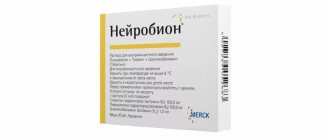Clindamycin
To avoid complications, use strictly as prescribed by your doctor!
There have been case reports of severe hypersensitivity reactions, including severe skin reactions such as drug rash with eosinophilia and systemic symptoms (DRESS syndrome), Stevens-Johnson syndrome, toxic epidermal necrolysis and acute generalized exanthematous pustulosis in patients receiving clindamycin therapy. If a hypersensitivity reaction or severe skin reaction occurs, treatment with clindamycin should be discontinued and appropriate therapy for these complications should be initiated (see sections "Contraindications" and "Side Effects").
The drug contains gasoline alcohol. There are reports that gasoline alcohol causes the development of Gasping Syndrome, which is
fatal
in children. Although therapeutic doses of the drug usually contain a dose of benzyl alcohol significantly lower than the dose at which the development of this complication was observed, the minimum amount of benzyl alcohol that has a toxic effect is unknown. The degree of toxicity of benzyl alcohol depends on the amount of drug administered and the ability of the liver and kidneys to detoxify chemical compounds. Premature and low birth weight infants are at higher risk of toxicity.
The amount of benzyl alcohol per 1 ml of drug solution is 9 mg.
Clostridium
difficile
associated diarrhea is observed with the use of almost all antibacterial drugs, including clindamycin, and manifests itself from mild forms of diarrhea to severe colitis with a fatal outcome.
Antibacterial drugs suppress the normal intestinal flora, which can contribute to increased proliferation of clostridia. Clostridium difficile
produces toxins A and B, leading to the development of
Clostridium difficile
associated diarrhea.
Hypertoxin-producing strains of Clostridium difficile
lead to increased morbidity and mortality because they may be resistant to antibiotic therapy and may require colonectomy for treatment.
All cases of diarrhea in patients during antibiotic therapy should be considered suspicious for the development of Clostridium difficile
associated diarrhea.
A thorough medical history is required if Clostridium difficile
associated diarrhea develops within 2 months after the prescription of antibacterial drugs.
Pseudomembranous colitis is manifested by diarrhea, leukocytosis, fever, abdominal pain (sometimes accompanied by the discharge of blood and mucus in the stool) and can develop both while taking clindamycin and 2-3 weeks after stopping treatment. After a diagnosis of pseudomembranous colitis is made, in mild cases it is sufficient to discontinue treatment and use ion exchange resins (colestyramine, colestipol); in moderate and severe cases, replacement of the loss of fluid, electrolytes and protein, and the prescription of an antibacterial drug effective against Clostridium difficile
, for example, vancomycin at a dose of 125-500 mg, or bacitracin at a dose of 25,000 units orally 4 times a day for 7-10 days, or metronidazole at a dose of 250-500 mg 3 times a day.
Drugs that reduce gastrointestinal motility should not be coadministered with clindamycin.
Clindamycin should be used with caution in patients with a history of gastrointestinal diseases, especially colitis. Antibiotic-associated colitis and diarrhea occur more frequently and more severely in debilitated and/or elderly patients.
When using all antibacterial agents, including clindamycin, excessive growth of microorganisms that are insensitive to this drug, especially yeast-like fungi, is possible. If superinfection develops, appropriate measures should be taken depending on the clinical situation.
Clindamycin should not be used to treat meningitis because it does not penetrate the blood-brain barrier well.
When using the drug in high doses, monitoring the concentration of clindamycin in the blood plasma is necessary. If treatment is carried out over a long period of time, liver and kidney function tests should be carried out regularly. In patients with impaired liver and kidney function, no dose adjustment of the drug is required, since clindamycin practically does not accumulate in the body if the drug is administered at intervals of 8 hours. Patients with severe hepatic and/or renal insufficiency should use the drug with caution and monitor liver function (“ liver" enzymes) and kidneys.
The drug should not be administered intravenously undiluted or simultaneously. The infusion must be carried out for at least 10-60 minutes (see section “Method of administration and dosage”).
Compound
Clindamycin capsules contain the active component clindamycin (hydrochloride form), as well as additional ingredients: talc, lactose monohydrate, corn starch, magnesium stearate.
The solution contains the active ingredient clindamycin (phosphate form), as well as auxiliary ingredients: benzyl alcohol, disodium edetate, water.
Clindamycin cream contains the active ingredient clindamycin (phosphate form), as well as auxiliary ingredients: macrogol 1500 , castor oil, sodium benzoate, propylene glycol, emulsifier No. 1.
Reviews of Clindamycin
There are different reviews about the drug online. There are opinions that the medicine effectively cures a number of diseases. However, there are also opinions that the medicine in the form of capsules, as well as suppositories with clindamycin, turned out to be ineffective.
Side effects are rarely written about. Women mention that when using the product intravaginally, burning and discomfort were noted. Some patients use acne cream and write that its regular use allows them to almost completely get rid of acne.
Indications for use
Clindamycin solution and tablets are used for the following diseases and conditions:
- diseases of an infectious-inflammatory nature that were provoked by the action of microorganisms sensitive to clindamycin ;
- infections of the ENT organs, as well as infectious diseases of the upper respiratory tract and lower respiratory tract;
- diphtheria , scarlet fever ;
- urogenital infections;
- infections of the oral cavity, abdominal cavity;
- infections of soft tissues and skin;
- septicemia (primarily anaerobic);
- acute and chronic osteomyelitis
- endocarditis ;
- taken for the prevention of intra-abdominal abscesses and peritonitis after intestinal perforation or after traumatic infection (combined with aminoglycosides).
Clindamycin cream and gel is used for bacterial vaginosis.
Indications for the use of suppositories with clindamycin:
- bacterial vaginosis , provoked by microorganisms sensitive to the substance.
Pharmacokinetics and pharmacodynamics
Clindamycin is completely and quickly absorbed from the gastrointestinal tract; with simultaneous ingestion of food, absorption slows down, while the concentration of the substance in the plasma remains unchanged. Penetrates into the tissues and fluids of the body, passes through the blood-brain barrier poorly, but in the case of inflammation of the meninges, permeability increases.
The maximum concentration in the blood is observed after oral administration after 0.75-1 hour, if intramuscular administration is carried out, after 1 hour in adult patients and after 3 hours in children. When administered intravenously, the highest concentration is observed at the end of the infusion.
Therapeutic concentrations in the blood are observed for 8-12 hours. The half-life is 2.4 hours. Metabolism occurs in the liver, producing active and inactive metabolites . Excretion takes place over 4 days through the kidneys and intestines.
When the drug is administered intravaginally, about 3% of the administered dose is systemically absorbed.
Clindamycin analogs
Level 4 ATC code matches:
Lincomycin Hydrochloride
Lincomycin
Structural analogues of the active ingredient are the drugs Dalatsin , Zerkalin , Clindamycin phosphate , Clindatop , Klimitsin , Klindafer , Klindes , Clindacin , Klindovit . A specialist should prescribe the optimal remedy.
Release form
The product is produced in the form of capsules, solution and vaginal cream.
Gelatin capsules have a purple body and a red cap. Inside there is a powder that may be white or white-yellow in color. Capsules are packed in blisters of 8 pieces, in a cardboard pack of 2 such blisters.
The solution, which is administered intravenously or intramuscularly, is clear and may be colorless or slightly yellowish. Contained in ampoules of 2 ml. There are 5 ampoules in blister packs, 2 packs in a cardboard box.
Vaginal ointment 2% can have white, yellowish-white, creamy shades. It has a weak specific aroma. Contained in aluminum tubes of 20 g or 40 g, the kit includes an applicator.
During pregnancy and lactation
Clindamycin in solution and capsules is not prescribed during pregnancy and lactation .
The product can be used intravaginally for women in the second and third trimesters of pregnancy. In the first months of pregnancy, it is prescribed only if the expected benefit outweighs the potential harm when using cream or suppositories. During lactation, you need to carefully weigh the expected benefits and potential harm. The product can only be used under the supervision of a physician.
Interaction
There is an increase in the effect of the aminoglycosides Streptomycin, Gentamicin , Rifampicin when taken simultaneously with Clindamycin.
Activates the effect of competitive muscle relaxants, as well as muscle relaxation caused by n-cholinergic blockers.
Not compatible with barbiturates, Ampicillin , Calcium gluconate , magnesium sulfate, Aminophylline.
Antagonism with Chloramphenicol and Erythromycin .
It is not recommended to take simultaneously with solutions that contain B vitamins
Clindamycin and drugs with antidiarrheal effects should not be prescribed simultaneously, as the likelihood of developing pseudomembranous colitis increases.
When used simultaneously with opioid analgesics , the effect of respiratory depression may increase, up to the development of apnea .
Cross-resistance has been observed between Lincomycin and Clindamycin. Antagonism between Erythromycin and Clindamycin also appears.
It is not recommended to use with other drugs for intravaginal administration.
pharmachologic effect
The substance clindamycin belongs to the group of lincosamide antibiotics. It has a wide range of effects and is a bacteriostatic.
In the body it binds to the 50S subunit of the ribosome and inhibits protein synthesis in microorganisms. Shows activity against Staphylococcus spp., Streptococcus spp. (the exception is Enterococcus spp.), Streptococcus pneumoniae, anaerobic and microaerophilic gram-positive cocci, Clostridium tetani, Clostridium perfringens, Corynebacterium diphtheriae, Mycoplasma spp., Bacteroides spp. (including Bacteroides melaningenicus and Bacteroides fragilis). Also demonstrates activity against anaerobic gram-positive, non-spore forming bacilli.
Most strains of Clostridium perfringens are also sensitive to this substance, but other varieties of clostridia (in particular Clostridium tertium, Clostridium sporogenes) demonstrate resistance to this drug. In this regard, for diseases caused by Clostridium spp., it is recommended to conduct an antibiogram before starting treatment.
The mechanism of action of this drug and its antimicrobial spectrum is close to lincomycin.
The phosphate form of clindamycin is inactive in vitro, but it is rapidly hydrolyzed in vivo to form clindamycin, which exhibits antibacterial activity.

